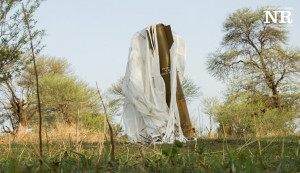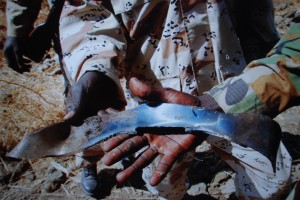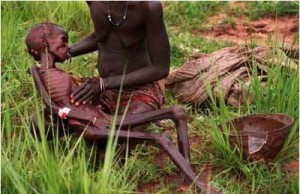Precisely two months ago I warned that the people of the Nuba Mountains (South Kordofan, Sudan) were deeply endangered by plans disclosed in leaked minutes of an August 31 meeting that included the most senior military and security officials of the Khartoum regime. I cited in particular two statements that were clearly never meant to be seen or heard by a wider audience. General Siddiq Amer, Director of Military Intelligence and Security, declared with remarkable directness:
“This year the Sudan People’s Army [Sudan Peoples Liberation Army-North—ER] managed to cultivate large areas in South Kordofan State. We must not allow them to harvest these crops. We should prevent them. Good harvest means supplies to the war effort. We must starve them, so that, commanders and civilians desert them and we recruit the deserters to use them in the war to defeat the rebels” (page 10 of English translation of minutes).
“We must starve them.” He is speaking of hundreds of thousands of civilians, for of course this ruthless assessment neglects to point out that the vast majority of agricultural production is a civilian undertaking, and that it will be Nuba civilians—primarily children, women, and the elderly—who will suffer most from this destruction of food supplies, not the rebels. Even more blunt are the words of General Imadal-Dindin Adawy, Chief of Joint Operations:
“We should attack them before the harvest and bombard their food stores and block them completely” (page 14).
One might have thought that with their plans so widely disseminated in the news, social media, and other sources, these génocidaires would alter or delay their plans. Not so. Late November and December are the height of the sorghum harvest season in the Nuba, and it is finally not surprising that Khartoum should forge ahead with its plans of civilian destruction by means of starvation. A report from a humanitarian organization with a tenuous presence in parts of the Nuba reports confidentially about the last week of November:
- during the week of 21-28 November six aerial raids by Antonov planes dropped a total of 32 bombs in six different locations. The attacks resulted in damage to farms and the immediate relocation of women and children to forests and riversides in Blue Nile and to rocks and caves in South Kordofan.
- [we have] been receiving reports of significant build-up of forces at the front lines and drone overflights spotted, that in the past have preceded aerial attacks on civilian locations. In addition, reports of escalation of ground fighting have also been received. [Drones have been used to identify food storage sites as well as concentrations of crops—ER]
- the Sudan Armed Forces has been deliberately burning large community farms, estimated to be as much as 400-500 fedans of sorghum fields in Dalami County. One fedan of cereal crops provides between 3-6 months of staple grain for a family of six. Thus, 500 fedans equates to 1500 people with no staple food for a year.
It is early December: this is only the beginning of Khartoum’s assault on the food supply of civilians in areas controlled by the Sudan Peoples Liberation Movement-North (SPLM-N).
Other recent research by the Enough Project offers equally grim data (from “Extermination by Design: The Case for Crimes against Humanity in Sudan’s Nuba Mountains,” The Enough Project | November 2014):
To better understand the toll of the government-imposed humanitarian blockade, in August 2014, a team of anonymous researchers conducted a detailed assessment of the living conditions of the people in the parts of South Kordofan controlled by the rebels. Their research found that households are cultivating 10 percent less land this year than in the previous year. The cumulative effect of three years of unrelenting war is that, alarmingly, cultivation has now dropped to one-fifth of pre-war levels. As a consequence, 70 percent of displaced households are consistently experiencing moderate or severe hunger.
Other indicators are equally alarming.
- Fifty-three percent of those surveyed in South Kordofan stated that the children in their home were not attending school regularly.
- Fifty-four percent claim that their primary [water] source dries up at some point during the year.
- Forty-seven percent have to walk more than five kilometers to reach a health facility.
- Sixty-six percent of households stated that their child had malaria in the preceding four weeks.
- Perhaps most striking, 70 percent of households stated that their primary barrier to food security was the insecurity caused by the violence.
Other sources confirm heavy fighting in the Dalami area in the northern part of the Nuba Mountains, signaling the start of yet another ruthless dry season defined by military violence. Such heavy fighting continues to threaten not only crops yet to be harvested, but the food that has already been harvested and thus concentrated in storage locations. These food storage sites are the targets of Khartoum’s relentless aerial bombardment, and were the most particular targets of ground assaults on Nuba villages in the last fighting season (November – June 2013).
The scale and intensity of aerial assaults has been ferocious for almost three and a half years (helicopter gunships were deployed by Khartoum against fleeing Nuba civilians shortly after the regime initiated conflict in South Kordofan on June 5, 2011). Nuba Reports recently noted (November 14) that Khartoum had “launched dozens of bombing raids on civilian areas in the Nuba Mountains and Blue Nile in the last week”:
Nuba Reports has confirmed 36 bombs dropped in the last ten days in South Kordofan. Two civilians were killed, and 12 wounded, including children. Meanwhile in Blue Nile state, a barrage of bombings killed a mother, and wounded three other civilians. The latest assaults bring the total number of bombs dropped on civilian targets to 2041.
Khartoum has also begun using so-called “parachute bombs,” which take considerable time to reach ground level and detonate long after the plane that dropped them is gone. This has created a new sense of terror among the Nuba people.
What Khartoum’s Use of Military Assets Against Civilians Tells Us
This savage use of aerial military assets against civilians has a long history (I chronicle much of this in “They Bombed Everything that Moved: Aerial military attacks on civilians and humanitarians in Sudan, 1999 – 2013,” which includes an extensive data spreadsheet). It remains the case for the Nuba, as well as Blue Nile and Darfur, that Khartoum’s aerial attacks on its own civilians is not meaningfully challenged in any fashion by the international community, creating a sense of complete impunity and ensuring that the attacks will continue. We see this sense of impunity most conspicuously in the deliberate aerial assaults on hospitals earlier this yeas. Last May and June two different hospitals in two locations within the Nuba Mountains—both known to be hospitals by the regime—were attacked.
The Mother of Mercy Hospital in Gidel (near Kauda) was attacked on May 1, 2014 by a Russian-built Sukhoi-24 military jet aircraft in a deliberate effort to destroy the hospital and kill Dr. Tom Catena, an American who is the only surgeon working in the Nuba Mountains—the only person able to piece together bodies torn apart by the shrapnel from barrel bombs dropped by the more familiar Antonovs (a retrofitted Russian-built cargo plane that flies at high altitudes and has no bomb targeting mechanism, ensuring they have no militarily useful accuracy). The Sukhoi-24 used on May 1, however, is another matter: although not a state-of-the-art air-to-ground attack aircraft, it has more than enough accuracy and fire-power against an undefended hospital, and considerable destruction was inflicted. In turn, people fled and the hospital was abandoned by those who were ambulatory. Not all patients were. As Nuba Reports noted at the time:
At 10am [May 1, 2014] the [Sukhoi-24] dropped 5 bombs in a straight line between the staff quarters and the hospital. Nobody was killed, but in a matter of minutes the hospital was emptied. Hundreds of patients and visitors fled into the bush, or caves in nearby mountains. [A video of this has been posted with the Nuba Reports dispatch.]
The aircraft was identified by Tom Catena, who began working in the Nuba even before the outbreak of fighting in 2011 and has courageously remained to do his singularly important surgical work (see my interview of Dr. Catena at http://wp.me/p45rOG-Zw ).
Six weeks later, the hospital of Doctors Without Borders/Médecins Sans Frontière(MSF) in Frandala was heavily bombed on June 16, inflicting severe damage and wounding six noncombatants—three of them severely. Perhaps unwisely, MSF had provided Khartoum with their location precisely so as to forestall such an attack.
During an aerial attack on a Sudanese village, Sudan’s air force bombed and partially destroyed a hospital run by the international medical humanitarian organization Médecins Sans Frontière/Doctors Without Borders (MSF) in the war-torn South Kordofan region on Monday, depriving civilians of critical medical care, the organization said today. As bombs struck the village of Farandalla [more commonly spelled Frandala] on 16 June, two hit the MSF hospital. Five people were wounded in the village and one MSF staff member was injured at the hospital. MSF medical teams treated the wounded and organized the transfer of three severely injured patients to another hospital. (MSF Press Release, 17 June 2014)
[A number of disturbing images of victims of Khartoum’s indiscriminate bombing of civilians in the Nuba may be found at: http://sudanreeves.org/2014/05/29/aerial-bombardment-of-the-nuba-mountains-continuing-terrorism-from-the-skies/ ; caution is urged, as some image are quite ghastly.]
What is notable, and a measure of Khartoum’s sense of impunity, is what occurred between the two attacks. In one sense, of course, nothing happened. But convinced that perhaps increasing the rhetorical volume might make a difference, the Obama administration had the United States ambassador to the UN, Samantha Power, issue an unusually strong statement, reported by Agence France-Press:
The US ambassador to the United Nations accused Sudan Thursday [12 June 2014] of intensifying attacks on civilians in South Kordofan and Blue Nile states, and of deliberately bombing schools and hospitals. Samantha Power condemned “in the strongest possible terms” attacks she said were being carried out by the Sudanese government and its rapid support forces against ordinary people. Ground and air attacks have increased since April, with hundreds of barrel bombs and other ordnance dropped on towns and villages, deliberately targeting hospitals and schools, she said. (Agence France-Presse [UN/New York], 13 June 2014)
All true. And yet four days later, Khartoum offered its response to this “condemnation”: it bombed the MSF hospital. Such contemptuous flouting of the U.S. is nothing new on Khartoum’s part, and for its part the U.S. had no further comment of significance—certainly nothing that harkened back to Ambassador Power’s statement of June 12. Inevitably, such a sequence of statements and actions only works to deepen the regime’s sense of impunity.
The shrapnel released from an Antonov “barrel bomb”–it can easily slice right through a human body.
The injuries caused are horrific
And it is this impunity that lies behind the burning of crops and the destruction of food storage sites that are apparently beginning in earnest, as they have for the past four agricultural cycles. And the human consequences are likely to be catastrophic: the Sudan Relief and Rehabilitation Organization, over a month before the ominous meeting of Khartoum’s security and military officials on August 31, warned:
Sudan Government offensive drives 1.1 million civilians to brink of starvation
Press Release from the Sudan Relief and Rehabilitation Organisation, Juba, South Sudan
Juba, 8 July 2014. Attacked from the air and from the ground, women and children have been forced to cower in caves. Fields have been left untilled and cattle uncared for. A carefully conducted survey, carried out at great risk by workers in the field, has revealed the scale of the looming catastrophe, which is detailed in the 4th SRRA report on the humanitarian and human rights situation of the war-affected people in Southern Kordofan and Blue Nile States of Sudan.
The dry season offensive – launched by the Sudanese Armed Forces in January this year – has driven civilians away from their homes and their farms. Now they are on the brink of catastrophe. The Sudanese authorities are well aware of the seasons for planting and harvesting and the intensification of bombardments reported in May, June and November, December and January, indicate that the Government is intentionally attempting to disrupt these critical periods in the agricultural year. It is a deliberate strategy designed to use of starvation as a weapon of warfare.
The Nuba Mountains, like Darfur, presents a spectacle of human suffering and destruction that are unconscionably neglected—though not for lack of knowledge of what is occurring. In addition to the multiple reports cited above:
UN Office for the Coordination of Humanitarian Affairs
Humanitarian Bulletin: Sudan | Issue 47 | 17 – 23 November 2014
Highest levels of food insecurity in Sudan are in SPLM-N areas, FEWS NET
The Famine Early Warning Systems Network (FEWS NET) reported in its September 2014 food security outlook report for Sudan that through December 2014 at least 20 percent of displaced people in Sudan Peoples Liberation Movement-controlled areas of South Kordofan [mainly the Nuba Mountains—ER] will experience Crisis (IPC Phase 3) levels of food insecurity. This is primarily due to restricted access to humanitarian assistance, ongoing conflict, and reduced access to cash income from seasonal agricultural labour.
[In the FEWS Net classification scheme, a “Crisis Phase” is defined in the following terms:
“At least 1 in 5 households face significant food consumption gaps with high or above usual acute malnutrition, or is marginally able to meet minimum food needs only with unsustainable coping strategies such as liquidating livelihood assets”—ER.]
According to FEWS NET, SPLM-North areas in South Kordofan have the highest level of food insecurity in Sudan. The Sudan Relief and Rehabilitation Agency (SRRA), the humanitarian arm of SPLM-N, reported in August 2014 that there were 500,000 displaced people in SPLM-N areas in South Kordofan and Blue Nile. UN agencies do not have access to SPLM-N areas and cannot verify the scope of civilian displacement and humanitarian needs in SPLM-N areas.
UN agencies do not have access because Khartoum refuses to grant any humanitarian access to the areas of the Nuba controlled by the SPLM-N. Even humanitarian assessments are conducted only at considerable risk by the SRRA, and occasionally by outside actors such as Enough.
How is it that the international community remains silent about the denial of humanitarian access to starving Nuba people—what amounts to a crime against humanity? How is it that the international community brings no significant pressure on Khartoum to halt its campaign of deliberately bombing civilian and humanitarian targets, again—in aggregate—crimes against humanity? Whether we look to South Kordofan, Blue Nile, Darfur, or the massively unreported suffering in eastern Sudan, why do these human realities not matter sufficiently to generate effective action? Why haven’t the countries of Europe imposed comprehensive economic sanctions on Khartoum, comparable to those of the U.S.?
And as Khartoum pushes toward it goal of starving the Nuba, why does the international community ignore the frankly avowed and well begun campaign of this regime?
“This year the Sudan People’s Army managed to cultivate large areas in South Kordofan State. We must not allow them to harvest these crops. We should prevent them. Good harvest means supplies to the war effort. We must starve them…
Yet again, there are no morally acceptable answers.
What starvation looks like; what does it say about the Khartoum regime that it is willing to use such suffering as a weapon of war?



